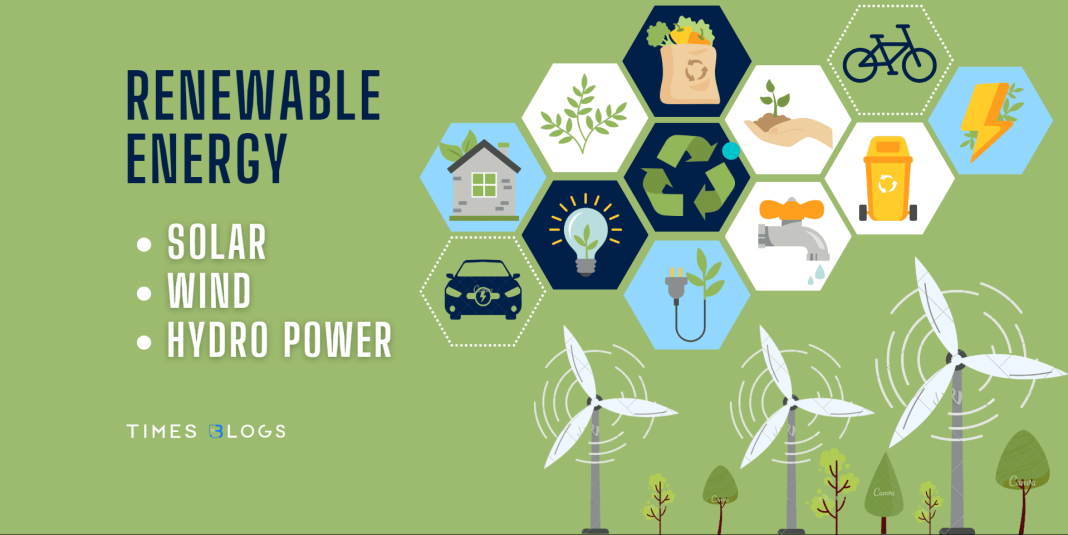Introduction:
Renewable energy sources are becoming more popular due to their cost-effectiveness, environmental friendliness and sustainability. Solar, wind and hydropower are the most commonly used renewable energy sources around the world. In this blog, we will discuss the innovations in these technologies and how they are changing the face of energy generation and consumption.
Benefits of Renewable Energy:
Renewable energy has many benefits compared to traditional fossil fuels. Here are some of the key benefits of renewable energy:
- Reduced Carbon Emissions: One of the biggest benefits of renewable energy is that it produces little to no carbon emissions, which are a major contributor to climate change. Renewable energy sources like solar, wind, and hydropower generate electricity without releasing greenhouse gases into the atmosphere.
- Energy Security: Renewable energy can provide energy security by reducing dependence on fossil fuels, which are often imported from other countries. Renewable energy sources are abundant and can be harnessed domestically, which can help to reduce the risk of energy supply disruptions.
- Economic Benefits: Renewable energy can provide economic benefits by creating new jobs and industries. Renewable energy industries are growing rapidly, and they are expected to continue to grow in the future. In addition, renewable energy can help to reduce energy costs over the long term, as the costs of renewable energy technologies continue to fall.
- Improved Public Health: Renewable energy can improve public health by reducing air pollution, which is a major health hazard. Fossil fuel combustion produces pollutants that can harm human health, including particulate matter, sulfur dioxide, and nitrogen oxides. Renewable energy sources do not produce these pollutants, which can help to reduce the incidence of respiratory and cardiovascular diseases.
- Water Conservation: Renewable energy sources like solar and wind power require very little water to generate electricity, which can help to conserve water resources. In contrast, traditional fossil fuel power plants require large amounts of water for cooling, which can strain water resources in dry areas.
- Sustainable Resource: Renewable energy is a sustainable resource, which means that it can be harnessed without depleting the resource. Fossil fuels are finite resources that will eventually run out, but renewable energy sources are constantly replenished by nature.
- Reduced Environmental Impact: Renewable energy can help to reduce the environmental impact of energy generation. Renewable energy sources do not produce the same level of environmental damage as fossil fuels, which can cause environmental problems like air and water pollution, land degradation, and habitat destruction.
Solar Energy Technologies:
Solar energy is one of the most promising renewable energy sources. With the advances in solar technology, solar panels have become cheaper and more efficient, making it an attractive option for households and businesses alike. Let’s take a closer look at some of the innovations in solar technology.
- Solar PV Panels:
Solar PV panels have undergone significant advancements in the past few years. The efficiency of solar panels has improved, and the cost has reduced drastically, making it an attractive option for households and businesses. The most significant development in solar panels has been the introduction of thin-film technology. Thin-film solar panels are made using materials such as copper, indium, gallium, and selenium. These materials are deposited onto a substrate, and the resulting film is used to generate electricity. Thin-film solar panels are cheaper to produce than traditional solar panels and can be installed on a wide range of surfaces.
- Solar Roof Tiles:
Solar roof tiles are an innovative approach to solar energy generation. Solar roof tiles are designed to look like traditional roofing materials and are installed in the same way. The advantage of solar roof tiles is that they can be installed on new and existing buildings without the need for additional mounting structures. Solar roof tiles are also more aesthetically pleasing than traditional solar panels.
- Concentrated Solar Power:
Concentrated solar power (CSP) is a technology that uses mirrors or lenses to focus sunlight onto a small area. The concentrated sunlight heats a fluid that drives a turbine to generate electricity. CSP has several advantages over traditional solar panels. CSP can generate electricity even when the sun is not shining, as the heat generated by the concentrated sunlight can be stored in molten salt. CSP also has a higher efficiency than traditional solar panels.
Wind Energy Technologies:
Wind energy is another promising renewable energy source. Wind turbines have become a common sight in many parts of the world. Let’s take a closer look at some of the innovations in wind technology.
- Offshore Wind Turbines:
Offshore wind turbines are becoming increasingly popular due to their higher efficiency and the availability of stronger winds offshore. Offshore wind turbines are more expensive to install than onshore turbines, but they generate more electricity due to the stronger winds offshore. Offshore wind turbines also have less of an impact on the environment than onshore turbines.
- Vertical Axis Wind Turbines:
Vertical axis wind turbines (VAWTs) are an innovative approach to wind energy generation. VAWTs are designed to rotate around a vertical axis, as opposed to traditional wind turbines, which rotate around a horizontal axis. VAWTs have several advantages over traditional wind turbines. VAWTs are more efficient in turbulent winds and are less affected by wind direction changes. VAWTs are also quieter and have a lower visual impact than traditional wind turbines.
- Wind Energy Storage:
Wind energy storage is becoming increasingly important as wind energy generation increases. Wind energy storage can be used to store excess electricity generated during times of high wind speeds, which can be used during times of low wind speeds. There are several technologies for wind energy storage, including batteries, compressed air energy storage, and pumped hydro storage.
HydroPower Technologies:
Hydropower is one of the oldest forms of renewable energy. Hydropower is generated by using the energy from falling water to turn turbines that generate electricity. Let’s take a closer look at some of the innovations in hydropower technology.
- Run-of-River Hydro Power:
Run-of-river hydropower is an innovative approach to hydropower generation. Run-of-river hydropower plants are designed to use the natural flow of a river to generate electricity, without the need for a dam or reservoir. Run-of-river hydropower plants have several advantages over traditional hydropower plants. They have a lower impact on the environment and can be installed in areas where traditional hydropower plants are not feasible.
- Tidal Energy:
Tidal energy is a form of hydropower that uses the energy from the tides to generate electricity. Tidal energy is generated by using turbines that are driven by the ebb and flow of the tides. Tidal energy has several advantages over traditional hydropower. Tidal energy is more predictable than other forms of renewable energy, as the tides are predictable. Tidal energy also has a lower impact on the environment than traditional hydropower, as the turbines can be installed offshore.
- Hydrogen Generation:
Hydrogen generation is an innovative approach to hydropower generation. Hydrogen can be produced by using electrolysis to split water into hydrogen and oxygen. The electricity required for electrolysis can be generated by hydropower. Hydrogen can be used as a fuel for transportation and power generation. Hydrogen is a clean-burning fuel that produces only water vapor as a byproduct.
Examples:
Here are some examples of innovative renewable energy technologies in solar, wind, and hydropower:
Solar Energy Technologies:
- Tesla Solar Roof Tiles – Tesla has developed solar roof tiles that are designed to look like traditional roofing materials, such as slate or terracotta. The tiles are made of tempered glass and have solar cells integrated into them. The tiles are more aesthetically pleasing than traditional solar panels and can be installed on new and existing buildings without the need for additional mounting structures.
- Thin-Film Solar Panels – Thin-film solar panels are made using materials such as copper, indium, gallium, and selenium. These materials are deposited onto a substrate, and the resulting film is used to generate electricity. Thin-film solar panels are cheaper to produce than traditional solar panels and can be installed on a wide range of surfaces.
- Concentrated Solar Power – Concentrated solar power (CSP) is a technology that uses mirrors or lenses to focus sunlight onto a small area. The concentrated sunlight heats a fluid that drives a turbine to generate electricity. CSP has several advantages over traditional solar panels. CSP can generate electricity even when the sun is not shining, as the heat generated by the concentrated sunlight can be stored in molten salt. CSP also has a higher efficiency than traditional solar panels.
Hydro Power Technologies:
- Hydrogen Fuel Cells: Hydrogen fuel cells are devices that generate electricity from hydrogen and oxygen, producing only water vapor as a byproduct. Fuel cells can be used to power vehicles, homes, and businesses.
- Water Splitting: Water splitting is the process of using electrolysis to split water into hydrogen and oxygen. The electricity required for electrolysis can be generated by renewable energy sources such as hydropower.
- Solar Hydrogen Production: Solar hydrogen production uses solar energy to power the electrolysis of water into hydrogen and oxygen. This technology can be used to produce hydrogen in areas with abundant solar energy, such as deserts.
In conclusion, renewable energy technologies are rapidly advancing and becoming more innovative. Solar, wind, and hydropower are the most common renewable energy sources, but there are many different technologies and approaches to their implementation. The innovations in these technologies are changing the face of energy generation and consumption, and it is clear that they will play a significant role in meeting the energy needs of the future. By investing in renewable energy technologies, we can reduce our reliance on fossil fuels and help to protect the environment.




